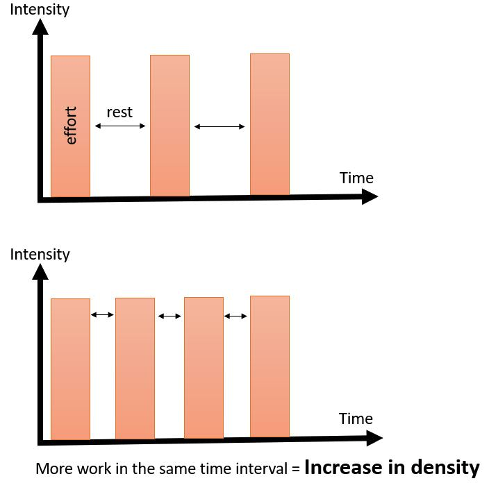
A Final Phases Story
In rugby, we have final phases at the end of the season that follows directly after the regular phase. We rarely have free weeks to prepare for these finals, which got me thinking. How can I make these rugby players perform better in a very short period of time?
In training, we often talk about doing speed or power blocks just before a deadline to improve the transfer on the field. We’ll also apply various peaking strategies by manipulating volume, intensity, frequency, etc. Unfortunately, the problem with these approaches is that they are often too complicated, especially for sports teams.
For example, doing a specific block of power and speed work could be a good idea, as power and speed are two essential performance factors in rugby and most team sports. However, even using a one-month block of preparation with three sessions per week would give us, at best, twelve training sessions on power and speed. And, unfortunately, I’m skeptical if twelve sessions will significantly affect the players' speed and power. The qualities of power and speed are the slowest to develop and the most complicated to evaluate in terms of progress.
RECENT: Variable Resistance Training for Team Sports
Progress in strength, power, and speed takes a long time. It is faster to improve an athlete's conditioning (i.e., energetic adaptation) than to make him gain thirty kilograms on a squat or increase his speed by one kilometer per hour/. Measuring progress on power and speed is also quite complicated in terms of accuracy and reliability, and it often requires expensive equipment such as accelerometers, speed cells, etc. Still, the peaking methods seemed rather complex to implement without impacting our performance in the weeks preceding the final phases. And they certainly wouldn’t work well for sports with single deadlines (e.g., fight sports, track and field, etc.)
Thus, I think the only factor of physical progression which seemed improvable in a short time—without negatively impacting the other physical qualities and the training of the players—is the capacity to repeat efforts (i.e., energetic adaptations). So, rather than try to have an immeasurable impact on power or speed in a short period, I decided to improve their ability to repeat their efforts using the concept of density.
Note: I think it is possible to improve strength, speed, or power in only twelve training sessions by using specific protocols such as high frequency. But the benefit-risk ratio does not favor these protocols during competition because athletes compete more and train less in the gym.

Concept of Density
In physical training, density is defined as the amount of work per unit of time. In a more practical sense, density is HOW MANY times in a given time frame you can reproduce a given effort. There is limited research on training density, except for the Enhance Density Training Principle (EDT). However, empirical logic can be sufficient to apply a concept in practice.
The Setup
Since my experience with Crossfit® more than ten years ago, I have incorporated the EMOM principle (Every Minute On the Minute) into my player’s training. With EMOMs, we can standardize the time of our training sessions in the gym and facilitate the coaching of our groups with a single timer or stopwatch. I simply replaced my traditional rest times with their equivalent in EMOM.
During my sessions, I use E4MOM (start every four minutes); E3MOM (start every three minutes), E2.5MOM (start every two minutes and 30), and so on. I coach on several racks simultaneously, where two to four players work. You just have to signal the start of each series for the first players of each group. This gives me a precise calibration of rest times and training density even when coaching large groups. You can even control the tempos of the repetitions with the same method. The fact that I was already using a stable unit of time to plan the workouts made it easier for me to implement the concept of density.
There are two ways to vary the density in training:
- Reduce time. The amount of work remains the same, but we reduce the timeframe. . For instance, you can change from 4 sets of 10 reps E2MOM to 4x10 with the same load but E1.5MOM.
- Increase work. The time frame remains the same, but the amount of work in the frame increases. For instance, you can go from 4x10 E2MOM to 4x12 E2MOM with the same load.
The benefits of increasing density are:
- Improved work capacity. Why is a high work capacity so important? If an athlete is in shape, lifting heavy weights and high-volume training days will have few negative effects on the lifter. If they are physically fragile, the training will affect them mentally and physically. So, if you have a high work capacity, a high-volume, high-intensity workout is not as tiring for you as it would be for someone out of shape. This enables you to train a little heavier, longer, and faster than your enemies(Simmons, 2007). Plus, increasing the density of training of an athlete will improve their physical condition and body composition.
- Faster progress.
- Progression without increasing the workload. This reduces joint and psychological wear and tear while still pushing the athlete forward.
- Breaking the monotony of training. Changing exercise methods brings mental freshness and motivation when the sequence of competitions is important. For example, you can use density training during the last week of a long block of matches.
- Increasing the sensation of perceived effort. Increased work sequencing creates a greater perception of effort, which can also keep athletes in a state of excitement and competitiveness (without increasing the actual intensity). By playing on the time interval, we can also reduce the duration of the sessions to reduce the training time and, thus, the training's internal load (RPE). The mental load of the session also reduces because we are guided by the rhythm of the EMOM.
- New stressors lead to new adaptations. For instance, increasing the number of repetitions, even without load variation, could also be beneficial for hypertrophy. (Daniel Plotkin, 2022)
Overall, this principle can be used in all types of efforts, from conditioning to running, to hypertrophy work, and so on.
How to Use During the Season
I use density training in three different situations.
- At the end of a long block of matches to bring a new form of work, stimulating motivation and reducing session time (internal load).
- In sessions with non-selected players to bring variation (e.g., when I’m training multiple athletes from different sports at once).
- In preparation for finals, to improve the players' ability to reproduce efforts.
Density Programming Example
Final Phases Preparation
Here is an example of the work I use to prepare for the final phases. The progression allows doubling the training density in six weeks of training. I use this cycle on the box squat. Note that the intensity is 85% in total, with 20% coming from elastic bands. This work block improves the ability to reproduce strength-power efforts on the lower limb (a performance factor in team sports).
Range of Repetitions in the Same Interval
Example: Perform 4 sets of 8-10 reps with a start every 2 minutes (E2MOM) using a load slightly less than 8RM. The goal is to increase the number of reps in each set without changing the load. Increase the load when all 4 sets are performed with the same load over 10 reps.
Example:
week 1: 4x8;
week 2: 1x9 3x8;
week 3: 1x10, 1x9, 2x8, etc.
I use this principle of increasing density for my upper body circuit.
The Hepburn Method
The Hepburn Method is based on a progressive increase in density. It works very well to increase strength and hypertrophy simultaneously.
A More Brutal Approach: EDT Training
Week 1 to 2: 25 reps at 80% as fast as possible
Week 3 to 4: 30 reps at 80% as fast as possible
Week 5 to 6: 35 reps at 80% as fast as possible
Week 7 to 8: 25 reps at 80% as fast as possible while trying to beat week 1 time.
Week 9 to 10: 25 reps at 82.5% as fast as possible.
This is a simple approach that works. I recommend not using this in-season unless the athlete can recover from it. Non-selected players or athletes in preperation can use it, though.
Double Progression
This is particularly suitable for power efforts.
A Running Example
German Volume Training Revisited
The "fun" session: 100 reps per exercise in 30 minutes! Watch out for DOMS, especially for strong athletes.
Limitations
Be careful; density work is not the same as metabolic conditioning (metcon) training. You must measure your density work objectively. To do this, measure intensity markers such as bar speeds (with an accelerometer or stopwatch), running speeds, or distances. You must ensure that the athletes maintain an execution adapted to the objective and not fall into efficiency to increase density (e.g., modifying pull-ups into Butterfly pull-ups). Set an intensity and execution that should not be modified.
Conclusion
Strength development influences all performance factors in sports. Increased strength leads to improved power (including rate of force development, or RFD), sprinting, jumping, change of direction, performance in sport-specific tasks, and reduces the risk and severity of injuries. (Suchomel, Nimphius, & Stone, 2016). Therefore, strength development must remain a priority in sports training.
References
- Daniel Plotkin, M. C. (2022). Progressive overload without progressing load? The effects of load or repetition progression on muscular adaptations. Peer Journal.
- Simmons, L. (2007). The Westside Barbell Book of Methods. Sakari Selkäinaho.
- Suchomel, T. J., Nimphius, •., & Stone, M. H. (2016). The Importance of Muscular Strength in Athletic Performance. Sports Medicine.
Header image credit: peopleimages12 © 123rf.com

Romain Guerin is a French strength and conditioning coach for professional rugby. He worked with the under 16 France team rugby league, rugby league academy, and police special forces. Romain earned his master's degree in sport science and other certifications like Westside Barbell® Special Strength Certificate and EXOS® certification. He can be reached at romainguerin.coachsport@gmail.com. Follow him on Instagram @romainguerin_pro.










Merci pour avoir partagé cette information --
Question:
En le «final phase preparation» pourquoi les total reps baisser et lève encore?
Je ne pige pas trop ça partie.
Merci!
-JG
En semaine 1, il s'agit encore d'un travail traditionnel avec une récupération classique E3MOM. Puis en semaine 2, on bascule sur le travail de densité E1.5MOM , c'est pourquoi le volume doit être baisser au départ.
Cordialement